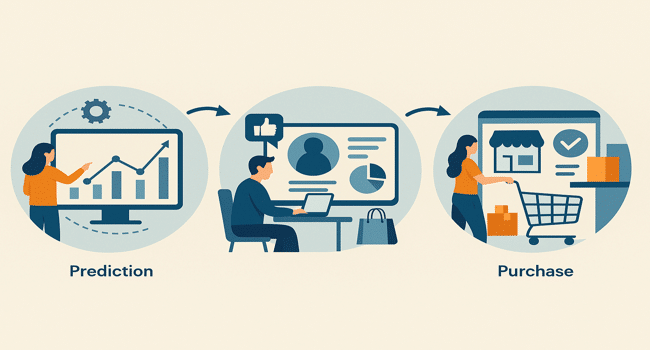Table of Contents
In retail, timing is everything. A sweater that’s a bestseller in January can be dead stock by February. A seasonal flavor may delight customers for three weeks before losing its charm. In such a fleeting market, the difference between profit and markdown often lies in how quickly a retailer can read the market’s pulse and respond.
Modern analytics platforms like Intellicus are transforming this agility into a structured cycle—predict, personalize, purchase—where each stage feeds the next in a loop of continuous improvement. This isn’t just a technology upgrade; it’s a rethinking of how decisions are made, with retail analytics, from inventory planning to customer engagement, powered by insights that come in real time and across every sales channel.
Predict: Anticipating What’s Next
Retail success starts long before a product hits the shelf. Prediction is ready the use of ancient sales styles, external marketplace alerts and actual-time transaction information to forecast call for before clients even begin surfing.
Think of it like climate forecasting: meteorologists don’t watch for rain to fall earlier than telling people to carry umbrellas. Similarly, predictive fashions help outlets put together for call for spikes, keep away from overstock and plan promotions proactively.
With an integrated view of each in-keep and on line channels, a supermarket chain could discover a surprising surge in interest for a regional snack—by means of combining POS statistics, e-trade search trends or even social chatter—allowing them to inventory up earlier than competition seize on.
Once the right merchandise are identified, the point of interest shifts from deliver-aspect readiness to demand-aspect precision: getting the proper offer to the right customer.
Personalize: Turning Data into Delight
Prediction brings the products in; personalization ensures they reach the right target audience inside the most compelling way.
By combining buy records, browsing behavior and loyalty software data, stores can craft offers that experience made for each consumer. Someone who buys gluten-free pasta often may acquire a promotion bundling it with clean produce and top class sauces.
Omnichannel personalization takes this similarly—making sure that whether a client is on a cellular app, internet site, or in a bodily save, the revel in feels constant and relevant. Real-time dashboards maintain vending teams in sync so promotions, inventory adjustments and pricing adjustments reflect right away throughout all touchpoints.
And as soon as clients are geared up to behave, analytics takes on a specific role—making the acquisition manner itself frictionless.
Purchase: Closing the Loop with Precision
If prediction is the forecast and personalization is the invitation, purchase is wherein execution topics maximum. This degree is about ensuring stock availability, streamlining checkout and gratifying orders appropriately—whether on-line or in-shop.
In bodily stores, position-primarily based analytics can assist ground managers monitor rapid-moving SKUs and cause restocking signals earlier than shelves empty. In e-trade, actual-time inventory sync guarantees customers don’t face the disappointment of “out of inventory” after checkout.
Retailers that tie purchase analytics back into their prediction engines see tangible profits. For example, a grocery chain reduced out-of-inventory incidents by way of 25% with the aid of using stay replenishment dashboards—at once increasing sales and customer pleasure.
Operational Agility: The Missing Link Between Insight and Impact
While prediction, personalization and purchase shape the spine of cutting-edge retail analytics, there’s a vital factor that determines how powerful they certainly are: the speed at which insights change into movement.
A extremely good forecast is vain if it takes weeks for vending to react. A perfectly focused advertising loses effect if it’s launched after the fashion has peaked. Operational agility guarantees that the complete organisation—now not simply the analytics crew—can respond at market pace.
This is in which embedded analytics and intuitive self-service gear trade the game. Instead of relying solely on analysts to drag reviews, save managers, class heads and advertising teams can immediately get right of entry to the insights applicable to their roles. For example:
- Store managers can see actual-time footfall and income, adjusting floor layouts to highlight trending merchandise.
- Merchandisers can immediately view gradual-transferring inventory by means of location and shift it to stores where it’s in call for.
- Marketing teams can display live marketing campaign performance and tweak messaging on the fly.
When anyone has the right insights at their fingertips—without ready in a reporting queue—decision-making will become faster, greater confident and greater aligned with customer wishes.
The Continuous Cycle
The are expecting–personalize–buy cycle is more than a linear process—it’s a residing device. Every transaction feeds new information into prediction fashions. More correct predictions allow for deeper personalization. Personalization increases the chance of buy. And the loop spins quicker whilst insights are generated in seconds, not days.
In these days’s competitive retail surroundings, success will belong to individuals who can unify facts from each channel, examine it in actual time and act with precision. Retailers who grasp this cycle don’t simply react to developments—they invent them.
By embracing omnichannel intelligence, real-time selection-making and position-specific insights, outlets can near the space among records and action. The end result isn’t simply higher income—it’s a greater resilient, adaptive business that thrives in an unpredictable market.
Read more on KulFiy
